The iPhone 5s Review
by Anand Lal Shimpi on September 17, 2013 9:01 PM EST- Posted in
- Smartphones
- Apple
- Mobile
- iPhone
- iPhone 5S
Display
The iPhone 5s, like the iPhone 5c, retains the same 4-inch Retina Display that was first introduced with the iPhone 5. The 4-inch 16:9 LCD display features a 1136 x 640 resolution, putting it at the low end for most flagship smartphones these days. It was clear from the get-go that a larger display wouldn’t be in the cards for the iPhone 5s. Apple has stuck to its two generation design cadence since the iPhone 3G/3GS days and it had no indication of breaking that trend now, especially with concerns of the mobile upgrade cycle slowing. Recouping investment costs on platform and industrial design are a very important part of making the business work.

Apple is quick to point out that iOS 7 does attempt to make better use of display real estate, but I can’t shake the feeling of being too cramped on the 5s. I’m not advocating that Apple go the route of some of the insanely large displays, but after using the Moto X for the past month I believe there’s a good optimization point somewhere around 4.6 - 4.7”. I firmly believe that Apple will embrace a larger display and branch the iPhone once more, but that time is just not now.
The 5s’ display remains excellent and well calibrated from the factory. In an unusual turn of events, my iPhone 5c sample came with an even better calibrated display than my 5s sample. It's a tradeoff - the 5c panel I had could go way brighter than the 5s panel, but its black levels were also higher. The contrast ratio ended up being very similar between the devices as a result. I've covered the panel lottery in relation to the MacBook Air, but it's good to remember that the same sort of multi-source components exist in mobile as well.
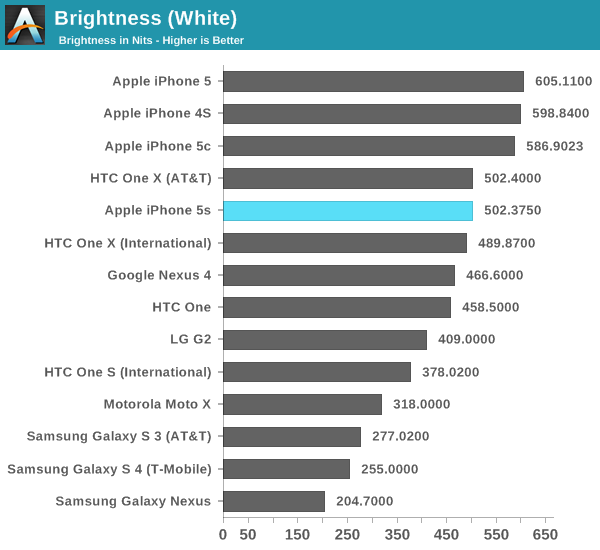
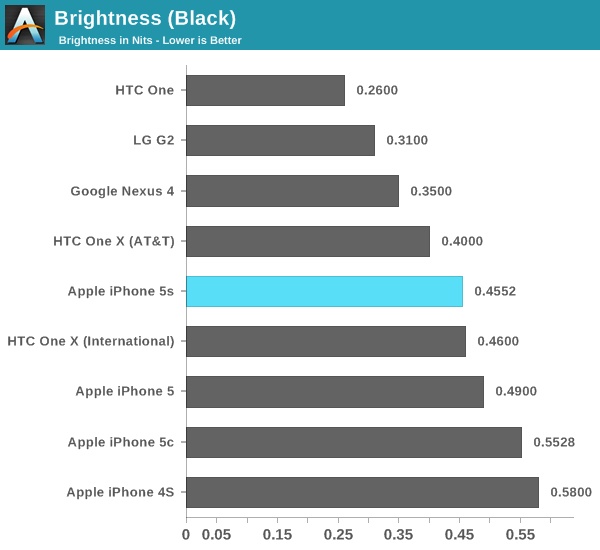
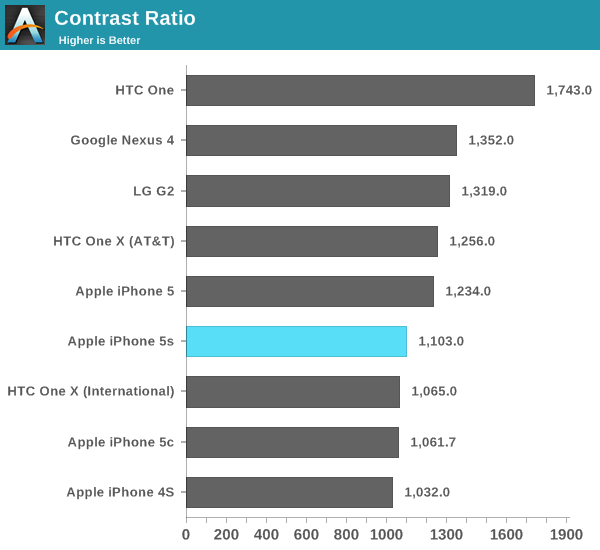
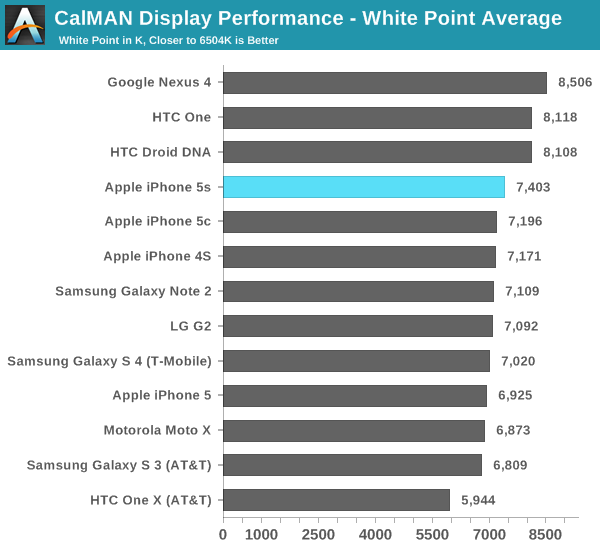

Color accuracy is still excellent just out of the box. Only my iPhone 5c sample did better than the 5s in our color accuracy tests. Grayscale accuracy wasn't as good on my 5s sample however.
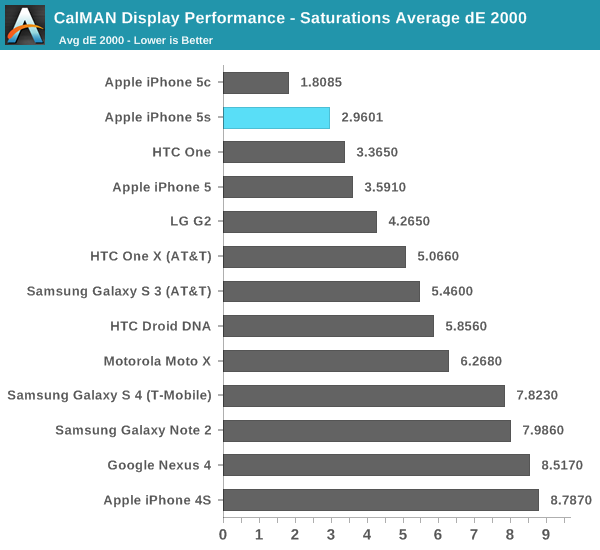
Saturations:

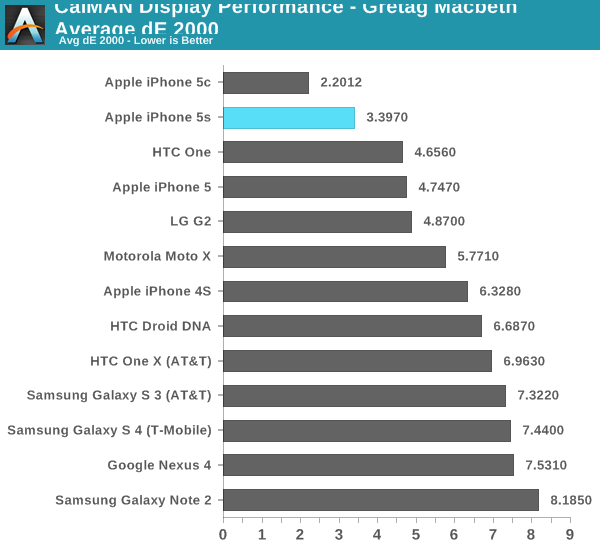
GMB Color Checker:

Cellular
When early PCB shots of the 5s leaked, I remember Brian counting solder pads on the board to figure out if Apple moved to a new Qualcomm baseband solution. Unfortunately his count came out as being the same as the existing MDM9x15 based designs, which ended up what launched. It’s unclear whether or not MDM9x25 was ready in time in order to be integrated into the iPhone 5s design, or if there was some other reason that Apple chose against implementing it here. Regardless of the why, the result is effectively the same cellular capabilities as the iPhone 5.
Apple tells us that the wireless stack in the 5c and 5s is all new, but the lack of LTE-Advanced features like carrier aggregation and Category 4 150Mbps downlink make it likely that we’re looking at a MDM9x15 derivative at best. LTE-A support isn’t an issue at launch, however as Brian mentioned on our mobile show it’s going to quickly become a much needed feature for making efficient use of spectrum and delivering data in the most power efficient way.
The first part is relatively easy to understand. Carrier aggregation gives mobile network operators the ability of combining spectrum across non-contiguous frequency bands to service an area. The resulting increase in spectrum can be used to improve performance and/or support more customers on LTE in areas with limited present day LTE spectrum.
The second part, improving power efficiency, has to do with the same principles of race to sleep that we’ve talked about for years. The faster your network connection, the quicker your modem can transact data and fall back into a lower power sleep state.
The 5s’ omission of LTE-A likely doesn’t have immediate implications, but those who hold onto their devices for a long time will have to deal with the fact that they’re buying at the tail end of a transition to a new group of technologies.
In practice I didn’t notice substantial speed differences between the iPhone 5s, 5c and the original iPhone 5. My testing period was a bit too brief to adequately characterize the device but I didn’t have any complaints. The 5s retains the same antenna configuration as the iPhone 5, complete with receive diversity. As Brian discovered after the launch, the Verizon iPhone 5s doesn’t introduce another transmit chain - so simultaneous voice and LTE still aren’t possible on that device.
Apple is proud of its support for up to 13 LTE bands on some SKUs. Despite the increase in support for LTE bands there are a lot of iPhone 5s SKUs that will be shipped worldwide:
| Apple iPhone 5S and 5C Banding | |||||||
| iPhone Model | GSM / EDGE Bands | WCDMA Bands | FDD-LTE Bands | TDD-LTE Bands | CDMA 1x / EVDO Rev A/B Bands | ||
|
5S- A1533 (GSM) |
850, 900, 1800, 1900 MHz | 850, 900, 1700/2100, 1900, 2100 MHz | 1, 2, 3, 4, 5, 8, 13, 17, 19, 20, 25 | N/A | N/A | ||
|
5S- A1533 (CDMA) |
800, 1700/2100, 1900, 2100 MHz | ||||||
|
5S- A1453 |
1, 2, 3, 4, 5, 8, 13, 17, 18, 19, 20, 25, 26 | ||||||
|
5S- A1457 5C- A1507 |
850, 900, 1900, 2100 MHz | 1, 2, 3, 5, 7, 8, 20 | N/A | ||||
|
5S- A1530 5C- A1529 |
1, 2, 3, 5, 7, 8, 20 | 38, 39, 40 | |||||
| Apple iPhone 5S/5C FCC IDs and Models | |||
| FCC ID | Model | ||
| BCG-E2642A | A1453 (5S) A1533 (5S) | ||
| BCG-E2644A | A1456 (5C) A1532 (5C) | ||
| BCG-E2643A | A1530 (5S) | ||
| BCG-E2643B | A1457 (5S) | ||
| BCG-E2694A | A1529 (5C) | ||
| BCG-E2694B | A1507 (5C) | ||
WiFi
WiFi connectivity also remains unchanged on the iPhone 5s. Dual band (2.4/5GHz) 802.11n (up to 150Mbps) is the best you’ll get out of the 5s. We expected Apple to move to 802.11ac like some of the other flagship devices we’ve seen in the Android camp, but it looks like you’ll have to wait another year for that.
I don’t believe you’re missing out on a lack of 802.11ac support today, but over the life of the iPhone 5s I do expect greater deployment of 802.11ac networks (which can bring either performance or power benefits to a mobile platform).
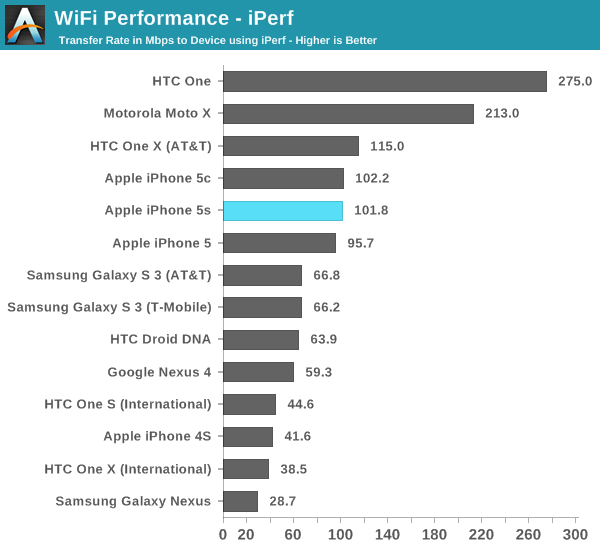
WiFi performance seems pretty comparable to the iPhone 5. The HTC One and Moto X pull ahead here as they both have 802.11ac support.













464 Comments
View All Comments
ddriver - Wednesday, September 18, 2013 - link
My basis for this conclusion is how the article is structured, the carefully picking of benchmarks and selective comparisons. This is clearly visible and has nothing to do with the actual chip specifications. It has nothing to do with execution mode specific details. So no, I don't have problem with facts, unlike you.Furthermore, that 30% number you were focused on is hardly impressive and proportional to the claims this article is making. In a workload that would take an hour, 30% is a noticeable improvement, but for typical phone applications this is not the case.
Dooderoo - Wednesday, September 18, 2013 - link
The structure of the article and the benchmarks are mostly the same as they use in most reviews, excluding some Android specific benchmarks. Where exactly do you see "carefully picking of benchmarks and selective comparisons". Put differently: what benchmarks should they include to convince you there is no "cunning deceit" at work?What claims in the article are not proportional with the 30% (actually more) performance gain?
I won't even comment on the "not a noticeable improvement" bit.
andrewaggb - Wednesday, September 18, 2013 - link
My issue with all the benchmarks is that they are mostly synthetic. The most meaningful benchmarks are the applications you plan to use and the usage patterns you are targeting. Synthetics are fascinating, but I think it's generally a mistake to buy anything based on them.notddriver - Thursday, September 19, 2013 - link
Um, so if a 30% improvement is hardly impressive and irrelevant to phones, then isn't the entire concept of reviewing phones on the basis of hardware performance also irrelevant? Which would make your complaints about the biased-yet-insignificant-review as vital as a debate over whether Harry Potter or Spiderman would be better at defending Metropolis.Incidentally, my iPhone 5 is powerful enough that I never notice any issues—as I'm sure the last generation of Android phones would be. But if your going to go to town over a dozen or more comments about a topic, at least pretend that it matters a tiny bit. Just good form.
oRdchaos - Wednesday, September 18, 2013 - link
I've seen people all over the web get very worked up about people's phrasing with regard to 64-bit. Would you prefer the title of the section were "Performance gains from a 64-bit architecture and the new ARMv8 instruction set"? People keep arguing that 64-bit in a vacuum doesn't give much performance gain. But there is no vacuum.I think the article is very clear to point out where gains are from additional instructions, versus a doubling of the register bit width, versus improved memory subsystem/cache. I'm sure when they get chances to write more of their own tests, they'll be able to pinpoint things further.
sfaerew - Wednesday, September 18, 2013 - link
engadget is multi-thread geekbench performance. tegra4 4cores vs A7 2coresSpoony - Wednesday, September 18, 2013 - link
- You are correct, there are no native cross-platform benches used. Which ones do you suggest Anandtech use? We all know Geekbench is essentially meaningless across platforms.- If you are talking about this engadget review: http://www.engadget.com/2013/09/17/iphone-5s-revie... It appears that Nvidia SHIELD (Tegra 4) led in only one benchmark out of six. This makes your statement incorrect. LG G2 is more competitive. Need we repeat how inaccurate Geekbench is cross-platform. It is as apples-to-oranges as the JS tests.
- I believe what Anandtech was attempting to show with the encryption was the difference ARMv8 ISA makes. In fact the title of that somewhat sensational chart is "AArch64 vs. AArch32 Performance Comparison". So while you are right, the encryption tests are handled in a fundamentally different way, that way is part of the ISA and is an advantage of AArch64, and thus is valid in the chart.
- It will be curious to see whether Qualcomm can deliver A7 like performance using ARMv7 with extended features. My position is no, which is the whole point of that entire page of the review. ARMv8 is actually enabling some additional performance due to ISA efficiency and more features.
- I think noticeable memory footprint bloat of a 64-bit executable is completely ridiculous. But to see if I was right, I did some testing. It's getting a bit hard to find fat binaries to take apart these days, most things are x86_64 only. But I found a few. I computed for three separate applications, took the average, and it looks like about a 9% increase in executable size. Considering that executables themselves are a tiny part of any application's assets, I think it is completely insubstantial. If you calculate the increase in executable size versus the size of the whole application package, it averages to a less than 1% increase.
I too am a bit sad that Apple didn't increase the RAM, and also equally sad that connectivity was left out this rev. I continue to be sad that there is not a more serious storage controller inside the phone. You make some valid points, but I think you also make some erroneous ones. The question with phone SoCs is: Is this a well balanced platform along the axes of performance (GPU and CPU), power consumption (thus heat), and features. I believe that the A7 is well calibrated. Obviously Qualcomm is also doing great work, and perhaps their SoCs are equally as well calibrated.
ddriver - Wednesday, September 18, 2013 - link
- This is entirely his decision, considering writing those reviews is his job, not mine. He can either use actual native benchmarks which reflect the performance of the actual hardware, or call it JS VM performance instead of CPU performance, because different JS implementations across platforms are entirely meaningless.- there is only one geekbench test at engadged. That is what I said "geekbench" - I did not imply it was faster in all tests in the engadged review, I don't know why you insinuate I did so. IIRC snapdragon 800 is actually a little slower in the CPU department than tegra 4, and only faster in the graphics department.
- the boost in encryption is completely disproportional to other improvements and is due to hardware implementations, not 64bit execution mode. So, if anything, it should be a graph or chart on its own, instead of using it to bulk up the chart that is supposed to be indicative of integer performance improvements in 64bit mode.
- maybe v7 chips with 128 bit SIMD units will not deliver quite the performance of A7, because there is more to the subject than the width of the registers (the number of registers doesn't really matter that much), like supported instructions. At any rate, v7 chips are still quad core, which means 4x128bit SIMD units compared to the 2 on A7, albeit with a few extra supported instructions. Until any native benchmark that guarantees saturation of SIMD units pops out, it will be a foolish thing to make a concrete statement on the subject. But boosting v7 SIMD units to 128bit width will at least make it competitive in number crunching scenarios, which use SIMD 99% of the time.
- this is very relative, you can store the same data in three different containers and get a completely different footprint - a vector will only use a single pointer, since it is continuous in memory, a forward list will use a pointer for every data element, a linked list will use two. Depending on the requirements, you may need faster arbitrary inserts and deletions, which will require a linked list, and in the case of a single byte datatype, a 32bit single element will be 12 bytes because of padding and alignment, while in 64bit mode the size will grow to 24 bytes, which is exactly double. Granted, this is the other extremity of the "less than 1%" you came up with, truth is results will vary in between depending on the workload.
As I said in the first post, the wise thing would be to reserve judgement until mass availability, mostly because I know corporate practices involving exclusive reviews prior to availability, which are a pronounced determining factor to the initial rate of sales. In short, apple is in the position to be greatly rewarded for imposing some cheating requirements on early exclusive reviewers. And at least in this aspect I think everyone will disagree, apple is not the kind of company to let such an opportunity go to waste.
ddriver - Wednesday, September 18, 2013 - link
*no one will disagreeDug - Wednesday, September 18, 2013 - link
I will."As I said in the first post, the wise thing would be to reserve judgement until mass availability, mostly because I know corporate practices involving exclusive reviews prior to availability, which are a pronounced determining factor to the initial rate of sales. In short, apple is in the position to be greatly rewarded for imposing some cheating requirements on early exclusive reviewers. And at least in this aspect I think everyone will disagree, apple is not the kind of company to let such an opportunity go to waste."
Prove it and stop making assumptions.